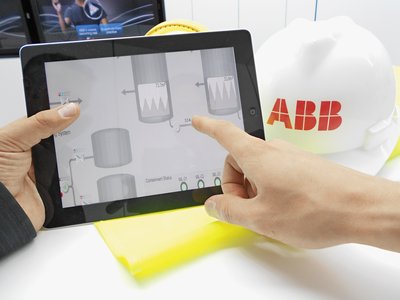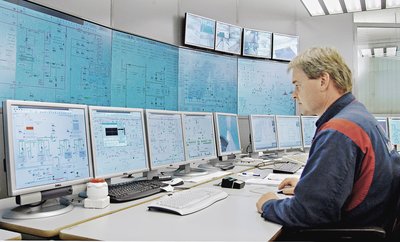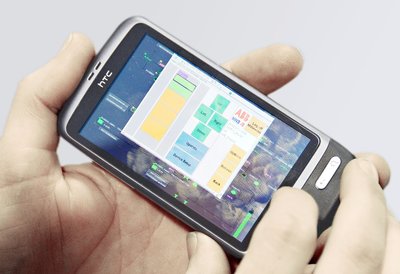Always in touch: adapting mobile devices to industrial applications
By Fredrik Alfredsson, Jonas Bronmark, Elina Vartiainen, Magnus Larsson and Petter Dahlstedt, ABB
Thursday, 05 September, 2013
Mobile devices have great potential to increase the efficiency, productivity and satisfaction of plant personnel in industrial settings, but despite the obvious gains to be had, mobile devices in industrial settings are not being utilised to their fullest.
The potential benefits of using mobile devices in industrial environments are many. Mobile devices could allow people to work more independently; there could be fewer errors as personnel access information on their mobile devices rather than relying on other people or one’s own memory; systems could be updated on the spot; and decision-makers could be contacted directly anytime. Mobility could considerably increase the efficiency of field workers as they could access real-time information away from their work stations or control rooms, enabling greater independence. And yet, despite the obvious gains to be had, mobile devices in industrial settings are not being utilised to their fullest.
Today, mobile devices are an essential part of people’s daily activities, enabling them to keep in contact through calling, texting, emailing and social media. Mobile devices are also used to create media (including photos and videos) that can be shared with others. Moreover, mobile devices are more than just communication devices: they can be used as a music player, a navigation device or a gaming platform, enabling a very powerful combination of technology that can be leveraged for industrial automation. The interaction techniques people use to control mobile devices (for example, touch, voice and gestures) have also evolved at a fast pace during recent years. For example, the introduction of well-designed, touch-enabled devices changed the smartphone market completely, and voice recognition (for example, Siri on the iPhone) and gesture recognition are finally at an acceptable level. These possibilities enable efficient interaction between the user and the mobile device even in situations where hand/eye interaction is not possible.

Challenges for mobile devices
The challenges of introducing mobile devices in industrial environments include network capability, current work practices, IT infrastructure, environment and safety equipment.
Network capability
An industrial plant may not have the necessary network infrastructure for mobile connectivity. This might be quite obvious in an underground mine, where the rock makes it very difficult to build a network that would provide good signal strength. Yet open-pit mines might not have good mobile network coverage either since they are often located in sparsely populated remote areas, which therefore have no need for commercial or proprietary mobile networks.
Current work practices
In many plants radio phones (walkie-talkies) are still an important means of communication between workers. Factories are often divided into many areas that use different radio frequencies for communication to prevent information overload. In some factories workers carry both a mobile device and a radio phone, as the mobile device has not been able to replace the functionality that radio offers.
IT infrastructure
Industrial IT systems usually contain a large amount of legacy software as they have been developed over several decades, and it might be difficult to integrate mobile devices into the existing process systems. For example, the mobile solutions introduced by customers might not be specifically designed for mobile devices but rather copied from a desktop environment.
Industrial processes also require extremely secure IT systems, which external persons are not able to access. Companies are concerned about utilising mobile devices as they could introduce more complexity and risks into their IT systems. The IT department might value system security more than providing mobile solutions that could improve efficiency. Understanding this trade-off is crucial when designing mobile solutions for industrial automation.
Environment
The multitude of different industrial environments also affects mobile device use. Some have impurities such as dust or dirt which can affect the touch capabilities. Other environments might have large temperature variations affecting the battery function and possibly making the mobile device work slower and with longer response times. Others might have humidity. Light conditions can also differ, thus impacting the colour scheme and lighting in the device to achieve the best contrast.
Safety equipment
Industrial environments require personnel to wear protective gear. The type of gear can vary based on the safety level of the process but, in general, safety boots, vests, helmets, gloves, ear protection and safety glasses are commonly used. Often protective gear is mandatory in certain areas; for example, when moving in tunnels inside a mine or walking around a plant. Yet today’s workers spend less time in dangerous areas, as they more often stay in control rooms or other office locations. Therefore, safety equipment is becoming less of a challenge in certain areas.
Assessing needs
Identifying and understanding the specific needs for mobile devices in industrial environments is essential when designing mobile solutions to create more efficient operators and field workers.
Research has shown that, for most organisations, rugged mobile devices are not wanted in locations where spark-free equipment is not a requirement (as, for example, in oil or gas platforms). Users prefer to replace broken or lost devices with new ones rather than pay extra for rugged options. Users want well-designed backup solutions that will keep the device content safe in case of an accident. The backup solutions would automatically save the content of the mobile device to a secure server to prevent information from getting lost in case of an accident.
And, of course, security must be very high since any break-in to the system could be disastrous. Yet the level of security should not affect the availability of the system: there is no use for mobile solutions if the information cannot be accessed when required.
Another important criterion is that the mobile device should fit into a pocket; otherwise, the device might stay on the work desk and not be carried along during assignments at the plant.

The ability to type with a full keyboard is not considered an issue since the mobile device is not meant to replace a desktop computer - it is just a tool when a field worker is on the move. In many cases, remote workstations for the automation system can be installed at strategic places around the plant for workers to access the process automation system remotely. These stations have a keyboard and a big screen and can be used when the capabilities of a mobile device are not enough. Learning to cope with certain limitations of smartphones - for example, the need to charge the phone daily - is also not considered an issue since the phone could be charged between one’s shifts together with other equipment that also needs to be charged - eg, lamps. Thus, special devices with extended battery durability might not be necessary.
Current mobile devices that have been specifically designed for industrial environments do not include the latest available interaction technologies such as multitasking or multitouch, nor are they equipped with sensors for measuring the orientation (gyro, accelerometer), proximity of other objects and light conditions. However, the latest smartphones in consumer markets offer these capabilities and a superior user experience. Workers in industrial settings have the same expectations of mobile devices when used as a work tool.
The main advantage of a mobile device in an industrial setting is the real-time access to all information, independent of the worker‘s location. The information includes the process data as well as manuals, blueprints and descriptions. Up-to-date information is vital for accessing process information. Today, this is accomplished by communicating via radio or phone with the operator in the control room.
For a mobile solution to work, it is important that everyone is included in mobile communication. All personnel should have a mobile device in order to be reachable. Otherwise, other communication methods are needed, which in turn add complexity to the communication. In an ideal case, people could contact anyone at the plant according to, for example, their availability, responsibility area or expertise without needing to know the actual phone number. The communication method (for example, phone or video call, text messages or chatting) could also be chosen according to the work task and availability of participants. This could minimise the operators being overloaded as they could answer some of the questions asynchronously. Mobile devices would also enable private communication, which is not possible with radio phones.

At times personnel in industrial settings use their work or even private mobile devices to take pictures or videos of issues encountered for documentation or to consult with their colleagues. However, they do not have any support for this task from the system or tools provided by their employer. Therefore, industrial mobile devices need to make it possible to collect and share information about the status of the industrial process more directly.
Application development
The rapid development of web and mobile applications is very different from the traditional release cycle normally used for industrial systems. Mobile applications have adopted a release cycle of weeks and months, adding new functionality and features as they are updated. The mobile app Angry Birds, for example, has constantly been adding more levels and new characters into the gameplay since it was released in late 2009. Similarly the Facebook application for iOS has also constantly been adding functionality over time instead of releasing a version that does every requested feature from day one.
Such a method for software development (ie, adding functionality in small but frequent instalments) is necessary in the mobile domain as the hardware and software is shifting so rapidly. That is, the top-of-the-line hardware today will be considered old and replaced by something else tomorrow. These quick software release cycles are something that the industrial sector will have to adapt to by releasing updates as frequently as any other apps for the mobile devices instead of releasing ‘super versions‘ that include every requested feature but with the price of a very long development phase.
Furthermore, with a shift toward quick development cycles it is possible to develop and release software for the industry that solves the most critical-use cases, where mobile solutions will make a huge impact. Continuous updates to the industry applications will then improve and add requested features. Also, ‘rapid prototyping‘ and mobile app development on mobile devices is inexpensive today, which makes the smartphone platforms attractive for industrial domains as well.
What lies ahead
The continuous progress in mobile technologies related to user experience and interaction techniques raises the need to allow existing HMIs to evolve so that personnel can use these techniques when interacting with plant systems. Future HMIs should utilise the best parts of these new inventions (including depth sensing, gestures, voice control and new display technologies) and enable users to interact with systems more efficiently and safely.
Research shows that with custom-made apps for well-understood scenarios and use cases, mobile device usage in industrial automation can be taken to a completely new level. New developments such as augmented reality, pico projectors and sensors for detecting the environment can make mobile devices even more powerful in several ways. Augmented reality shows a live view of the reality through, for example, a camera view of a mobile device. The view is then augmented by computer-generated content (graphics). Augmented reality could benefit, for example, maintenance engineers to show more equipment-related information. For instance, the system could visualise important information related to a device (such as the liquid level in a tank).
Pico projectors are small, handheld projectors that can project full-size images onto any surface. When these are attached to mobile devices (some mobile devices already include one, for example, Samsung Beam), any surface can be used as a display. Then, a maintenance engineer could use his pico projector to project, for example, instructions related to maintenance work directly on top of the device that needs repair.
Mobile devices already include sensors such as a gyroscope and accelerometer to detect the orientation of the device. In the future, mobile devices will probably include more sensors such as infrared cameras or smell detectors to record data about the environment. This information could be used to check if there are abnormal gases in the air or if some equipment has overheated. The gyro and accelerometer could be used to detect where the maintenance engineer is pointing, and identify the device in question to give him more information related to the device.
Microgrids: moving towards climate change resilience
The benefits of microgrids go far beyond support during a natural disaster and can provide...
Good for today, ready for tomorrow: how the DCS is adapting to meet changing needs
The future DCS will be modular and offer a more digital experience with another level of...
Software-based process orchestration improves visibility at hydrogen facility
Toyota Australia implemented software-based process orchestration from Emerson at its Altona...












